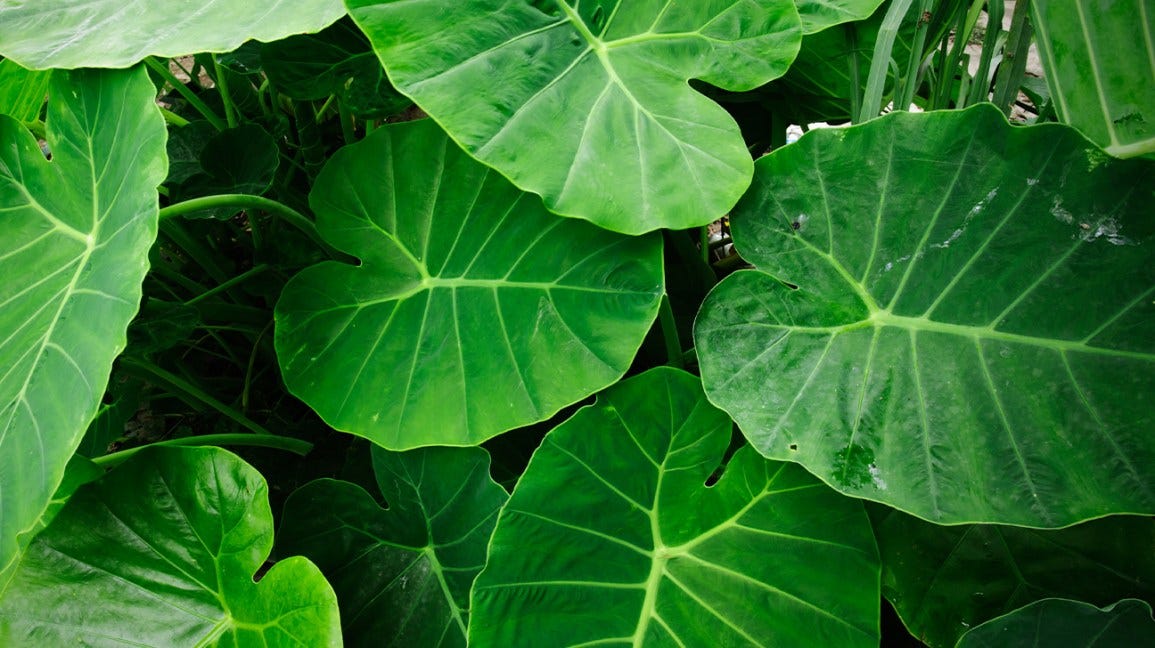Callaloo stew, and the beauty of the unfamiliar.
Adapted from: the national dish of Trinidad and Tobago.
One of life’s purest pleasures that remains unspoiled by the pandemic—and likely intensified because of it—is the process of discovering something entirely foreign to me. Having no frame of reference, no previous experience to judge against, is freeing. Most recently, I felt that electric jolt after tasting a side dish recommended by a new Caribbean restaurant in the neighbourhood, which was—in flavour and in texture—like nothing I’d ever tasted. It was chunky and slippery at once, almost viscous, with complex green notes that were floral and bright, yet simultaneously earthy. “Callaloo” was written in Sharpie on the container. A new word, too.
This word, as I’ve learned since, bears many meanings. It’s the name of the dish itself—a popular Caribbean dish, originally introduced to the islands by West African slaves. It’s also the colloquial name for the leaf vegetable that constitutes the main ingredient of the dish, which changes depending on the locale. In Jamaica, callaloo refers to amaranth leaves. In Trinidad and Tobago, it’s another name given to taro leaves, also known as dasheen. Elsewhere, it could mean malanga, bok choy, or water spinach. No one could agree on how to spell it, either:

As a dish, it has just as many variants. Jamaican callaloo is stir fried relatively dry, with tomatoes and thyme, making for a vegetable side dish that holds its shape. Trini callaloo is cooked down in coconut milk, with the addition of okra, which gives it that signature viscosity. Sometimes a crab is added; sometimes yam or salt pork. Sometimes it is chunky, stew-like; sometimes watery and soupy. I see a cousin in the Afro-Brazilian dish, caruru, which also features okra, albeit not in a supporting role.
In Trinidad and Tobago, Sunday lunch is a sacred tradition, and callaloo is a mainstay. Here’s Brigid Washington, author of this week’s recipe, reflecting on the historic significance of the dish:
With a reverence that I had never witnessed from Mum regarding any type of food, she expounded on the history of callaloo; particularly, how it remains inextricably linked to the carefree realities of my all-girl Catholic high school existence. She challenged me to see beyond the ingredients and to imagine a time back when our ancestors crossed the Middle Passage, bound, beaten, and branded; a time when choice wasn’t an option. She reminded me of callaloo’s civic prestige—as Trinidad and Tobago’s national dish—duly designated by emancipated slaves-turned-citizens-turned-statesmen, acquainted with its place in the nation’s history.
“There’s a reason we eat callaloo on Sunday,” she said. “It’s the only day that slaves didn’t have to work on the sugar plantations.”
The jolt of novelty, then reverence—for the beautiful things that emerge from the cruelest of circumstances. The things that stay.
Recipe notes
Trini Callaloo - Brigid Washington, Bon Appetit
The recipe calls for many substitutions already (spinach and collard greens instead of taro leaves, for example), so I felt less guilty substituting further. I didn’t have scallions, so I used chives. I didn’t have butternut squash or pumpkin, so I used a leftover delicata squash. The result tasted fairly close to the one from the restaurant, if my memory and singular experience means anything!
Variations on callaloo
• The Jamaican version (no okra or coconut milk), via food blog Healthier Steps.
• Another version from Trinidad that features pork and crab, via The Spruce Eats.
• Callaloo inception: from “Reading "Callaloo"/Eating Callaloo: A Special Thirtieth Anniversary Issue of Callaloo, A Journal of African Diaspora Arts and Letters.
Have you discovered a dish that made you feel displaced, transported, like a small tadpole in a very big pond? Tell me about it.
Until next time,
Tracy 🥬




